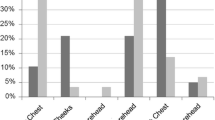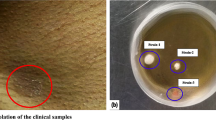Abstract
The prevalence ofM. furfur, a lipodependent fungus, in the skin of 0 to 15-year-old healthy children was studied. Sterilized carpet was used to collect skin samples which were cultured in Oxgall medium (Difco) with 1% olive oil and incubated for 10 days at 37 °C.M. furfur was recovered in 17.8% of infants, with similar findings in both sexes. The highest prevalence ofM. furfur colonization was found among children of 0 to 18 months and 11 to 15-year-olds, with 23.3% and 26.7% respectively.
Similar content being viewed by others
References
Abraham Z, Berderly A, Lefler E.Pityrosporum orbiculare in children. Mykosen 1987; 30: 581–583.
Aschner JL, Punsalang A, Maniscalco WM, Menegus MA. Percutaneous central venous catheter colonization withMalassezia furfur: Incidence and clinical significance. Pediatrics 1987; 80: 535–539.
Baptista G. Incidência, características morfológicas, fisiológicas, e antigênicas de leveduras do gêneroMalassezia. Tese de Doutorado, Escola Paulista de Medicina. São Paulo, 1984.
Bergbrant IM, Broberg A.Pityrosporum ovale culture from the forehead of healthy children. Acta Derm Venereol (Stockholm) 1994; 74: 260–261.
Faergemann J, Fredriksson T. Age incidence ofPityrosporum orbiculare on human skin. Acta Dermatovener (Stockholm) 1980; 60: 531–533.
Faergemann J, Aly R, Maibach HI. Quantitative variations in distribution ofPityrosporum orbiculare on clinically normal skin. Acta Derm Venereol (Stockh) 1983; 63: 346–348.
Gordon MA. Lipophilic yeast-like organisms associated with tinea versicolor. J Invest Derm 1951; 17: 267–272.
Mariat F, Tapia G. Denombrement des champignons kératinophiles d'une population de cynocéphales (Papio papio). Ann Parasitologie 1966; 41: 627–634.
Martínez-Roig A, García-Pérez A, Bonastre M, Madrenys N, Gallach G, Torres-Rodríguez JM. Study of healthy carriers ofM. furfur among children population. Rev Iber Micol 1991; 8: 16–18.
McGinley KJ, Lantis LR, Marples RR. Microbiology of tinea versicolor. Arch Derm 1970; 102: 168–171.
Midgley G. Morphological variation inMalassezia and its significance in pityriasis versicolor. Dimorphic fungi in biology and medicine. New York, Plenum Press, 1993.
Noble WC, Midgley G. Scalp carriage ofPityrosporum species: The effect of physiological maturity, sex and age. Sabouraudia 1978; 16: 229–232.
Powell DA, Hayes J, Durrell DE, Miller M, Marcon MJ.Malassezia furfur skin colonization of infants hospitalized in intensive care units. J Pediatr 1987; 111: 217–220.
Roberts SOB.Pityrosporum orbiculare: Incidence and distribution on clinically normal skin. Br J Derm 1969; 81: 264–269.
Author information
Authors and Affiliations
Additional information
Part of the Ms. thesis of Victor Silva ‘Associação deMalassezia furfur com patologias com componente seborréico’.
Rights and permissions
About this article
Cite this article
Silva, V., Tilia, C.D. & Fischman, O. Skin colonization byMalassezia furfur in healthy children up to 15 years old. Mycopathologia 132, 143–145 (1995). https://doi.org/10.1007/BF01103979
Received:
Accepted:
Issue Date:
DOI: https://doi.org/10.1007/BF01103979




